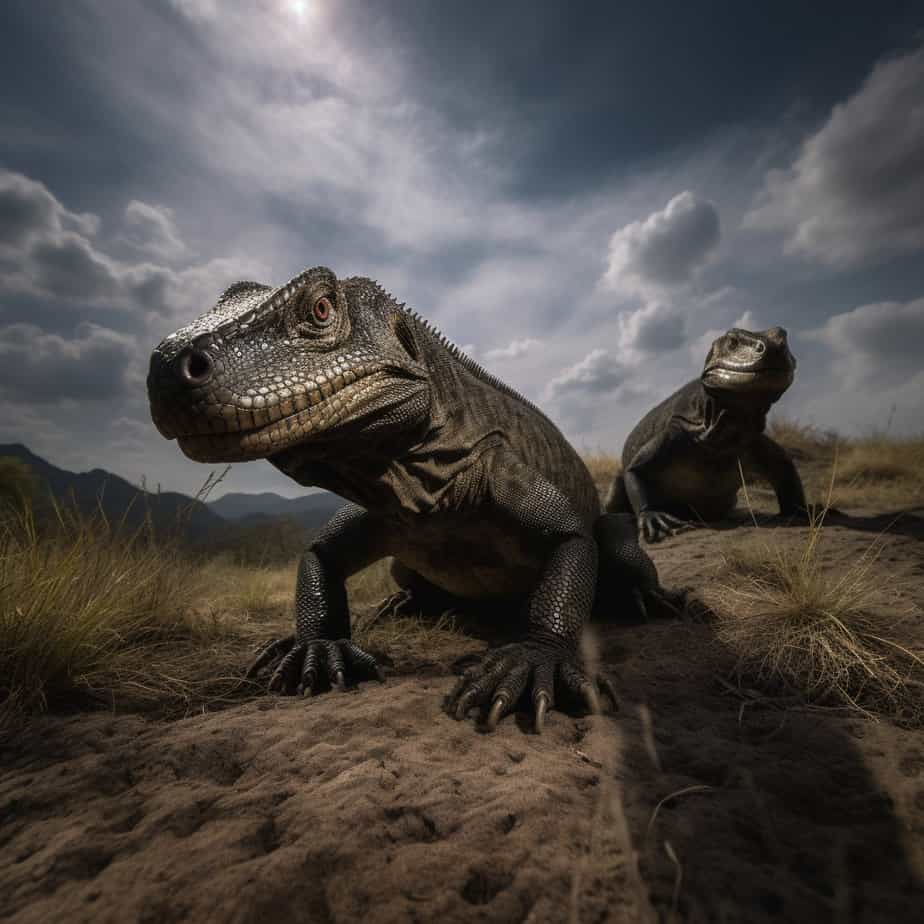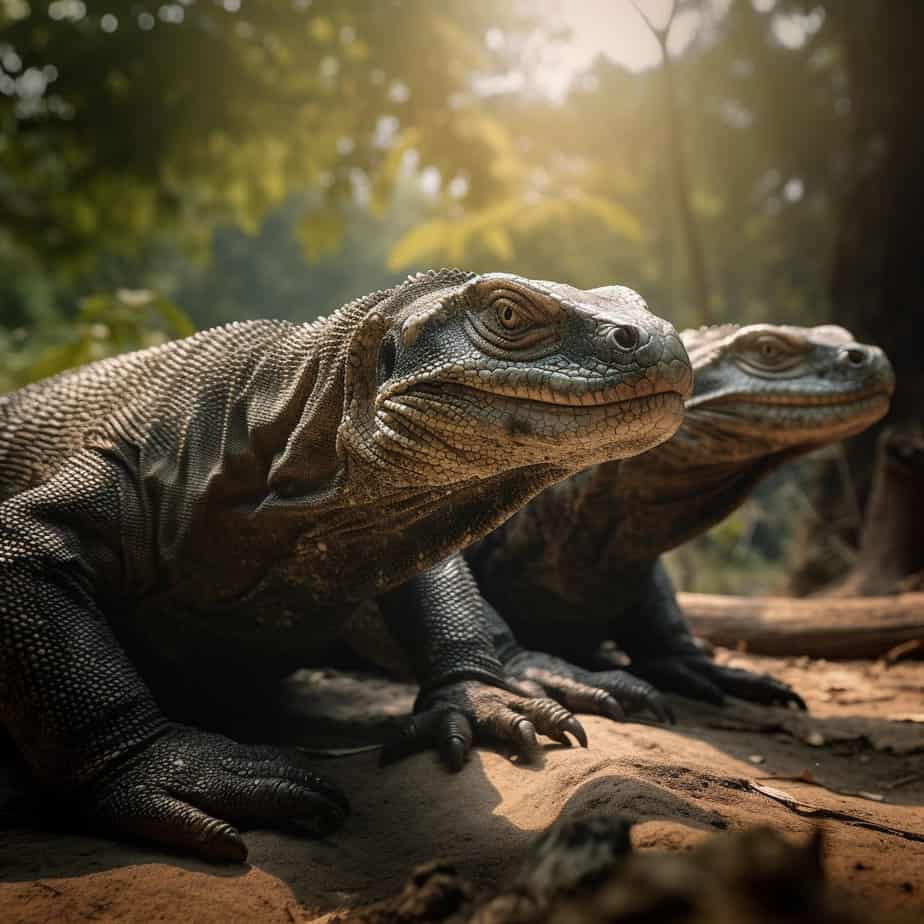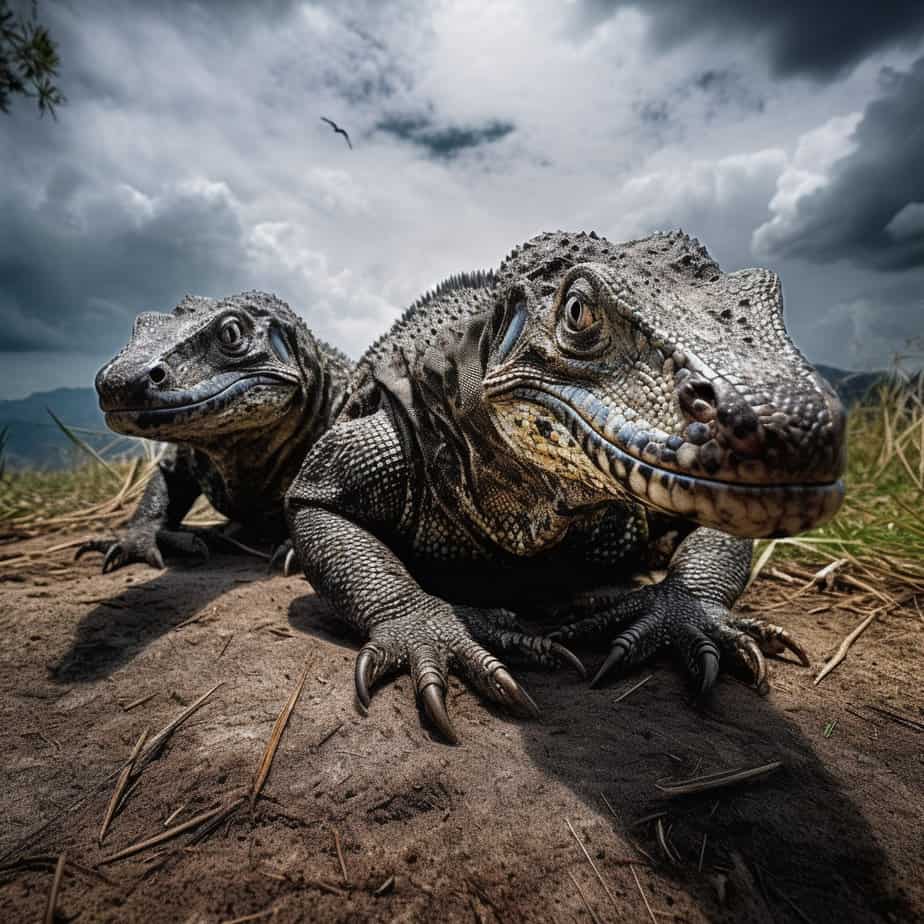The Komodo dragon and the buffalo are two formidable creatures that inhabit different parts of the world. The Komodo dragon, native to the Indonesian islands, is the largest lizard species on Earth, known for its impressive size and deadly bite. On the other hand, the buffalo, found in various parts of the world, is a massive herbivore known for its strength and resilience. In this article, we will explore the characteristics and behaviors of these two animals and delve into the potential outcome of a confrontation between them. So, let’s dive into the fascinating world of the Komodo dragon and the buffalo.
Key Takeaways
- Komodo dragons are the largest lizards in the world, while buffaloes are large herbivorous mammals.
- Komodo dragons have a venomous bite, while buffaloes have powerful horns for defense.
- Komodo dragons are solitary hunters, while buffaloes live in herds for protection.
- Komodo dragons rely on stealth and ambush tactics to catch their prey, while buffaloes use their size and strength to defend against predators.
- Both species play important roles in their respective ecosystems and are fascinating examples of adaptation and survival.
Understanding the Komodo Dragon and the Water Buffalo

A. The Komodo Dragon: An Overview
The Komodo dragon, scientifically known as Varanus komodoensis, is a fascinating reptile that inhabits the Indonesian islands of Komodo, Rinca, Flores, Gili Motang, and Padar. It is the largest living lizard in the world, growing up to 10 feet in length and weighing around 150 pounds. These impressive creatures have captured the imagination of wildlife enthusiasts and researchers alike.
Physical Characteristics
Komodo dragons have several unique physical characteristics that set them apart from other reptiles. Their scaly skin is a mottled combination of gray, brown, and green, providing excellent camouflage in their natural habitat. They have a long, muscular tail, powerful limbs, and sharp claws that aid in their hunting and climbing abilities.
One of the most distinguishing features of the Komodo dragon is its serrated teeth. These teeth are not only sharp but also harbor a deadly bacteria that can cause severe infections in their prey. Additionally, they possess a venom gland in their lower jaw, which injects venom into their victims, further incapacitating them.
Hunting Techniques
Komodo dragons are skilled hunters, employing both ambush and pursuit techniques. They have a keen sense of smell and can detect carrion from miles away. When hunting, they rely on their stealth and patience, waiting for the perfect moment to strike. Once they spot their prey, they use their powerful legs to sprint towards it, reaching speeds of up to 13 miles per hour.
When the Komodo dragon catches its prey, it delivers a powerful bite, often targeting the legs or throat. The combination of their sharp teeth, powerful jaws, and venomous saliva quickly immobilizes their victim. After the initial attack, the Komodo dragon patiently waits for the venom and bacteria to weaken the prey before consuming it.
B. The Water Buffalo: A Brief Profile
The water buffalo, scientifically known as Bubalus bubalis, is a large mammal that is native to Southeast Asia. It is a domesticated animal and plays a significant role in the region’s agriculture and culture. Water buffaloes are known for their immense strength and resilience, making them well-suited for various tasks.
Physical Traits
Water buffaloes are massive animals, with males, known as bulls, weighing up to 2,600 pounds and standing around 6 feet tall at the shoulder. They have a stocky build, with a large head and curved horns that can span up to 6 feet. Their coat is usually black or dark gray, providing protection from the sun and insects.
Defense Mechanisms
When faced with a predator, such as the Komodo dragon, water buffaloes rely on their size and strength to defend themselves. They have a strong charge, capable of reaching speeds of up to 30 miles per hour, which can be a formidable deterrent to potential attackers. Additionally, their sharp horns can inflict serious injuries, making them a force to be reckoned with.
Water buffaloes also exhibit a unique behavior known as “mobbing.” When threatened, they gather in a tight-knit group, forming a circle with their young in the center. This defensive formation makes it difficult for predators to single out an individual buffalo, increasing their chances of survival.
In conclusion, the Komodo dragon and the water buffalo are both remarkable creatures in their own right. While the Komodo dragon relies on its stealth, venom, and powerful bite to subdue its prey, the water buffalo uses its size, strength, and defensive behaviors to ward off potential threats. The predator-prey relationship between these two species showcases the intricate dynamics of the animal kingdom and the strategies employed for survival.
The Komodo Dragon vs. The Water Buffalo: A Comparative Analysis
A. Physical Attributes: Size, Strength, and Speed
When comparing the Komodo dragon and the water buffalo, it’s important to consider their physical attributes, as these play a crucial role in determining their capabilities in the wild.
Komodo Dragon
The Komodo dragon, also known as Varanus komodoensis, is a large reptile native to the Indonesian islands. It is the world’s largest lizard, with males reaching lengths of up to 10 feet and weighing around 150 pounds. Females are slightly smaller, typically measuring around 6 to 7 feet in length.
Despite their massive size, Komodo dragons are surprisingly agile and can move quickly when hunting or defending their territory. They have muscular bodies and powerful legs, allowing them to sprint at speeds of up to 12 miles per hour in short bursts.
Water Buffalo
On the other hand, the water buffalo, scientifically known as Bubalus bubalis, is a large mammal that inhabits various regions of Asia. It is one of the largest bovid species, with males weighing up to 2,600 pounds and standing around 6 feet tall at the shoulder. Females are slightly smaller, but still impressive in size.
Water buffalos possess immense strength, which is evident in their muscular build and robust horns. They are not known for their speed, as they are more adapted for endurance rather than quick bursts of movement. However, when threatened, they can charge at speeds of up to 30 miles per hour, making them a force to be reckoned with.
B. Survival Instincts: Defense Mechanisms and Predatory Tactics
Survival in the animal kingdom requires a combination of effective defense mechanisms and predatory tactics. Let’s explore how the Komodo dragon and the water buffalo utilize these strategies.
Komodo Dragon
Komodo dragons are formidable predators, relying on a combination of stealth, strength, and venom to bring down their prey. Their sharp, serrated teeth and powerful jaws allow them to deliver a devastating bite, capable of inflicting serious injury or even death.
One of the Komodo dragon’s most unique attributes is its venomous saliva. It contains a mix of bacteria that can cause septicemia, a life-threatening infection. After biting its prey, the dragon will often wait patiently for it to succumb to the infection before consuming it.
In terms of defense mechanisms, Komodo dragons have tough, scaly skin that provides protection against potential threats. Additionally, they have a keen sense of smell and excellent vision, allowing them to detect prey from a distance and ambush it effectively.
Water Buffalo
Water buffalos, on the other hand, are known for their strong herd instincts and formidable defense mechanisms. When faced with a predator, such as a Komodo dragon, they will often gather together in a protective circle, with their horns facing outward.
The buffalo‘s massive horns serve as a powerful deterrent to potential attackers. They can use them to charge at predators, inflicting severe injuries with their sharp tips. Additionally, their size and strength make it challenging for predators to bring them down.
Water buffalos also have a thick, tough hide that acts as a natural armor, providing protection against bites and scratches. Their herd mentality and coordinated defense strategies make them a formidable opponent, even for large predators like the Komodo dragon.
In conclusion, the Komodo dragon and the water buffalo possess unique physical attributes and survival instincts that contribute to their respective roles in the animal kingdom. While the Komodo dragon relies on its size, speed, and venomous bite to hunt, the water buffalo utilizes its strength, endurance, and herd mentality to defend against predators. Understanding these differences allows us to appreciate the fascinating dynamics of nature’s predators and their prey.
The Deadly Encounter: How Does a Komodo Dragon Kill a Water Buffalo?
A. The Hunting Strategy of a Komodo Dragon
When it comes to the predator-prey relationship in the animal kingdom, few encounters are as fascinating and intense as that between a Komodo dragon and a water buffalo. These two formidable creatures, representing the apex predators of their respective domains, engage in a battle for survival that showcases the raw power and cunning strategies of nature’s predators.
The Komodo dragon, native to the Indonesian islands, is the largest living lizard in the world. With its massive size and powerful jaws, it possesses the ability to take down prey much larger than itself. Despite its sluggish appearance, the Komodo dragon is an agile and stealthy hunter, employing a combination of patience, intelligence, and brute force to secure its meal.
When hunting a water buffalo, the Komodo dragon relies on its acute sense of smell to locate its target. It can detect the scent of a carcass from miles away, allowing it to track potential prey with precision. Once the dragon has identified a buffalo, it begins to stalk its victim, moving silently and slowly, taking advantage of its excellent camouflage to remain undetected.
As the dragon closes in on its prey, it waits for the opportune moment to strike. When the buffalo is within range, the Komodo dragon launches a lightning-fast attack, using its powerful legs to propel itself towards the unsuspecting herbivore. With jaws capable of delivering a bone-crushing bite, the dragon aims for the buffalo’s vulnerable areas, such as the neck or throat, aiming to incapacitate its prey quickly.
B. The Water Buffalo’s Response: Fight or Flight?
In a battle between a Komodo dragon and a water buffalo, the buffalo is not without its own defenses. Water buffaloes are large, robust mammals known for their strength and resilience. When faced with a predator like the Komodo dragon, these formidable creatures have two primary responses: fight or flight.
When a water buffalo senses the presence of a Komodo dragon, it assesses the threat level and decides whether to stand its ground or flee. If the buffalo chooses to fight, it uses its massive size and sharp horns as weapons. With a powerful charge, it can deliver a devastating blow to the dragon, potentially injuring or even killing it.
However, if the buffalo determines that escape is the best option, it relies on its agility and speed to outrun its reptilian pursuer. Water buffaloes are surprisingly nimble for their size, capable of reaching speeds of up to 35 miles per hour. By utilizing their herd instincts, they can also coordinate their movements, making it difficult for the Komodo dragon to single out a target.
In some cases, a water buffalo may even seek refuge in water, using its ability to swim as a means of evading the dragon. The Komodo dragon, being a reptile, is not as proficient in aquatic environments, giving the buffalo a temporary advantage.
In the deadly encounter between a Komodo dragon and a water buffalo, the outcome is not always predictable. While the dragon possesses incredible strength and hunting techniques, the buffalo’s size, speed, and defensive mechanisms make it a formidable opponent. These battles in the animal kingdom serve as a reminder of the intricate balance of nature and the survival strategies employed by different species. Can a Komodo Dragon Kill a Water Buffalo?
A. Analyzing Past Instances
When it comes to the battle between a Komodo dragon and a water buffalo, it’s important to consider the past instances where these two formidable creatures have crossed paths. In the wild, encounters between the Komodo dragon and the water buffalo are relatively rare, but they do happen. These encounters provide valuable insights into the dynamics of predator-prey relationships in the animal kingdom.
In the Indonesian wilderness, where both the Komodo dragon and the water buffalo call home, clashes between large reptiles and large mammals are not uncommon. The Komodo dragon, being one of nature’s most fearsome predators, relies on its size, strength, and hunting techniques to take down its prey. On the other hand, the water buffalo, a powerful and robust herbivore, possesses its own set of defense mechanisms to ward off potential threats.
In instances where a Komodo dragon has targeted a water buffalo, the outcome is not always in favor of the reptile. While the Komodo dragon possesses a powerful bite and venomous saliva, the water buffalo’s sheer size and strength can prove to be a formidable challenge. Water buffaloes are known to charge at their predators with great force, using their sharp horns as weapons. This defensive behavior often catches the Komodo dragon off guard, forcing it to retreat or abandon its hunting attempt altogether.
B. The Role of Venom in Komodo Dragon’s Hunting Strategy
One of the most fascinating aspects of the Komodo dragon’s hunting strategy is its use of venom. Contrary to popular belief, the Komodo dragon’s venom does not directly kill its prey. Instead, it serves as a means to weaken and incapacitate the victim, making it easier for the reptile to overpower and eventually consume it.
The Komodo dragon’s venom contains a potent cocktail of toxins that can cause a variety of effects on its prey. These toxins include anticoagulants, which prevent blood from clotting, and compounds that induce shock and paralysis. When the Komodo dragon bites its prey, it injects its venom into the wound, allowing the toxins to take effect.
In the case of a water buffalo, the venomous bite of a Komodo dragon can certainly cause significant harm. However, due to the buffalo’s size and thick hide, it is more resilient to the effects of the venom compared to smaller prey. The water buffalo‘s robust nature and powerful defense mechanisms provide it with a higher chance of survival in an encounter with a Komodo dragon.
In conclusion, while the Komodo dragon is a formidable predator in its own right, the water buffalo’s size, strength, and defensive capabilities make it a challenging target. The outcome of a confrontation between a Komodo dragon and a water buffalo is highly dependent on various factors, including the individual animals involved and the circumstances of the encounter. These instances serve as a reminder of the fascinating dynamics of the animal kingdom and the survival strategies employed by its inhabitants.
The Symbiotic Relationship between Komodo Dragon and Water Buffalo

A. The Dynamics of their Interaction
The relationship between the Komodo dragon and the water buffalo in the wild is a fascinating example of nature’s intricate web of predator-prey dynamics. While the Komodo dragon is known for its formidable hunting skills and the water buffalo for its sheer size and strength, these two species have developed a unique symbiotic relationship that has shaped the ecosystem they inhabit.
When it comes to combat in the animal kingdom, the Komodo dragon is undoubtedly one of nature’s most impressive predators. These large reptiles, native to the Indonesian islands, possess a set of characteristics that make them formidable hunters. With their sharp teeth, powerful jaws, and venomous bite, they are well-equipped to take down prey much larger than themselves.
On the other hand, the water buffalo, a large mammal found in the same habitat as the Komodo dragon, possesses its own set of traits that aid in its defense against predators. These herbivores are known for their massive size, with some individuals weighing up to 2,000 pounds. They have strong horns and a thick hide, providing them with a formidable defense against potential threats.
When a Komodo dragon sets its sights on a water buffalo, it must employ various hunting techniques to overcome the buffalo’s defense mechanisms. The dragon relies on its stealth and patience, waiting for the opportune moment to strike. Once it bites its prey, it injects venom into the wound, causing the buffalo to weaken over time. The Komodo dragon then patiently tracks its prey until it succumbs to the venom.
B. The Impact on the Ecosystem
The interaction between the Komodo dragon and the water buffalo has a significant impact on the ecosystem they inhabit. While the Komodo dragon benefits from the buffalo as a source of food, the buffalo plays a crucial role in shaping the behavior and survival strategies of the dragon.
The presence of the Komodo dragon in the ecosystem helps regulate the population of the water buffalo. By preying on weaker or sick individuals, the dragon ensures that only the fittest members of the buffalo herd survive and reproduce. This natural selection process helps maintain the overall health and genetic diversity of the buffalo population.
Additionally, the carcasses left behind by the Komodo dragon after feeding provide a valuable source of food for other scavengers in the ecosystem. This includes birds, insects, and smaller carnivores, which play their own roles in maintaining the delicate balance of the ecosystem.
In turn, the buffalo’s presence and behavior also influence the Komodo dragon’s hunting strategies. Buffalos are known to gather in herds, which makes it challenging for a single dragon to successfully hunt them. This forces the Komodo dragon to rely on stealth and patience, carefully selecting weak or isolated individuals as potential prey.
Overall, the symbiotic relationship between the Komodo dragon and the water buffalo showcases the intricate connections within the natural world. It highlights the interdependence of species and the ways in which predator-prey interactions shape the behavior and survival strategies of both parties. This dynamic interaction contributes to the overall health and balance of the ecosystem they call home.
The Unusual Relationship: Komodo Dragon and Water Buffalo

A. The Interplay of Predator and Prey
In the wild, the relationship between predators and their prey is a delicate dance of survival. One such fascinating interaction can be observed between the formidable Komodo dragon and the mighty water buffalo. These two creatures, each representing the pinnacle of their respective species, engage in a battle for dominance that showcases the incredible power and adaptability of nature.
The Komodo dragon, known as the largest lizard on Earth, is a native of the Indonesian islands. With its massive size, sharp claws, and a venomous bite, it is a force to be reckoned with. On the other hand, the water buffalo, a herbivorous mammal, is one of the largest land animals in Asia. Its sheer size and strength make it a formidable opponent.
When these two giants cross paths, it is a clash of titans. The Komodo dragon, relying on its stealth and patience, stalks its prey, waiting for the perfect moment to strike. It uses its keen sense of smell to detect the scent of a weakened or injured buffalo, honing in on its target. Once the dragon has closed in, it launches a lightning-fast attack, delivering a powerful bite that injects venom into its victim.
B. The Balance of Nature: Survival of the Fittest
The water buffalo, however, is not an easy target. These massive creatures have evolved their own defense mechanisms to fend off predators. Living in herds, they rely on strength in numbers to deter attacks. When a Komodo dragon approaches, the buffalo will form a defensive circle, with the calves positioned in the center for protection. This strategy makes it difficult for the dragon to single out a vulnerable target.
Moreover, the water buffalo’s size and weight give it an advantage in combat. If a Komodo dragon manages to bite a buffalo, the battle is far from over. The buffalo‘s thick hide and powerful muscles make it resilient to the dragon’s venom. In fact, studies have shown that buffalo have a high resistance to the toxic effects of the Komodo dragon’s saliva, allowing them to survive even after being bitten.
In the wild, these encounters between Komodo dragons and water buffalos serve as a reminder of the intricate balance of nature. The predator-prey relationship is a crucial component of the ecosystem, ensuring the survival of the fittest. While the Komodo dragon relies on its hunting prowess and venomous bite, the water buffalo’s strength and herd mentality provide it with a formidable defense.
In conclusion, the interplay between the Komodo dragon and the water buffalo is a captivating spectacle of the animal kingdom. These battles of strength and strategy highlight the incredible adaptability and survival instincts of both species. As nature continues to evolve, these encounters will remain a testament to the delicate balance that exists in the wild. Conclusion
In conclusion, the battle between the Komodo dragon and the buffalo is a fascinating clash of two powerful creatures. Both animals possess unique strengths and strategies that they employ in order to survive and thrive in their respective environments. While the Komodo dragon relies on its venomous bite and stealthy hunting techniques, the buffalo relies on its sheer size, strength, and herd mentality to ward off predators. In a direct confrontation, the buffalo’s size and aggression give it a clear advantage over the Komodo dragon. However, the Komodo dragon’s venomous bite and ability to ambush its prey make it a formidable opponent. Ultimately, the outcome of such a battle would depend on various factors such as the size and health of the buffalo, the Komodo dragon’s hunting tactics, and the element of surprise. It is important to remember that in nature, survival is not always determined by brute force alone, but by a combination of adaptability, strategy, and luck. The clash between these two remarkable creatures serves as a reminder of the incredible diversity and complexity of the natural world.
Frequently Asked Questions
Q1: What are the main characteristics of a Komodo dragon and a buffalo?
A: Komodo dragons are large reptiles native to Indonesia. They have strong, muscular bodies, sharp claws, and a venomous bite. Buffaloes, on the other hand, are large mammals known for their strength, herd behavior, and powerful charges. They have a thick hide and strong horns that they use for defense.
Q2: Can a Komodo dragon kill a water buffalo?
A: Yes, a Komodo dragon can kill a water buffalo. Despite their size difference, Komodo dragons have a venomous bite that can cause severe infection, leading to the death of the buffalo over time.
Q3: How does a Komodo dragon kill a water buffalo?
A: The Komodo dragon uses a stealthy hunting technique. It waits in ambush and delivers a venomous bite, then retreats and waits for the venom to weaken the buffalo. The dragon then follows the buffalo until it succumbs to the venom.
Q4: What is the predator-prey relationship between a Komodo dragon and a water buffalo?
A: The Komodo dragon is a predator of the water buffalo. The dragon hunts the buffalo for food, using its venomous bite to eventually bring down the buffalo.
Q5: Is there a symbiotic relationship between a Komodo dragon and a water buffalo?
A: No, there is no symbiotic relationship between a Komodo dragon and a water buffalo. Their interaction is primarily predator-prey, with the Komodo dragon being the predator.
Q6: How does a buffalo defend itself against a Komodo dragon?
A: Buffaloes use their strength, size, and powerful charges to fend off predators. They also have strong horns and a thick hide that can provide some protection against a Komodo dragon’s bite.
Q7: How does the strength of a Komodo dragon compare to that of a buffalo?
A: While buffaloes are physically stronger and larger than Komodo dragons, the dragons have a venomous bite that can incapacitate or kill a buffalo. The strength of a Komodo dragon lies in its stealth, speed, and venom, rather than physical power.
Q8: What are the outcomes of a Komodo dragon vs buffalo encounter?
A: The outcome of a Komodo dragon vs buffalo encounter can vary. If the dragon is able to deliver a venomous bite, it’s likely that the buffalo will eventually die. However, if the buffalo can fend off the dragon with its strength and powerful charge, it may survive the encounter.
Q9: What role does the buffalo play in the Komodo dragon’s diet?
A: The buffalo is a significant part of the Komodo dragon’s diet. The dragon’s venomous bite allows it to take down large mammals like the buffalo, providing it with a substantial meal.
Q10: How common are encounters between Komodo dragons and buffaloes in Indonesian wildlife?
A: Encounters between Komodo dragons and buffaloes are relatively common in areas where their habitats overlap, such as the Indonesian islands where Komodo dragons are native. These encounters are a key part of the local ecosystem’s predator-prey dynamics.




